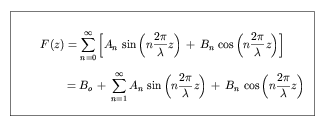
 , we can express the function
as a superposition of sine and cosine terms.
(For a bounded function where F(z=0) = F(z=
, we can express the function
as a superposition of sine and cosine terms.
(For a bounded function where F(z=0) = F(z= ) = 0,
sine terms alone will suffice.)
) = 0,
sine terms alone will suffice.)
 |
where Bo, An, and Bn are the Fourier coefficients. We find the form of Bo as follows, by integrating our expression for F(z) over a full period. For an arbitrary value of z which we will call z1,
 |
and we deduce that
 |
taking advantage of the symmetry of both sine and cosine functions over a full period:
 |
To find Am, where m is any value of n, we
multiply our expression for F(z) by
sin (m 2 z /
z /
 ) and again
integrate over a complete period.
) and again
integrate over a complete period.
 |
leading to
 |
making use of symmetry and the fact that
 |
To find Bm, we multiply our expression for F(z) by
cos (m 2 z /
z /
 ) and again
integrate over a complete period.
) and again
integrate over a complete period.
 |
leading to
 |
again making use of symmetry, and the fact that
 |
You should be able to determine which coefficients are non-zero simply by sketching a few quick curves.